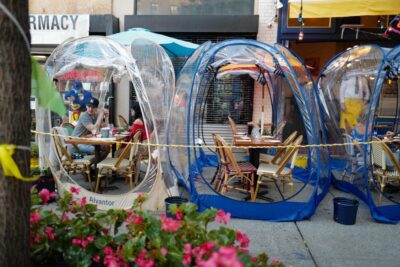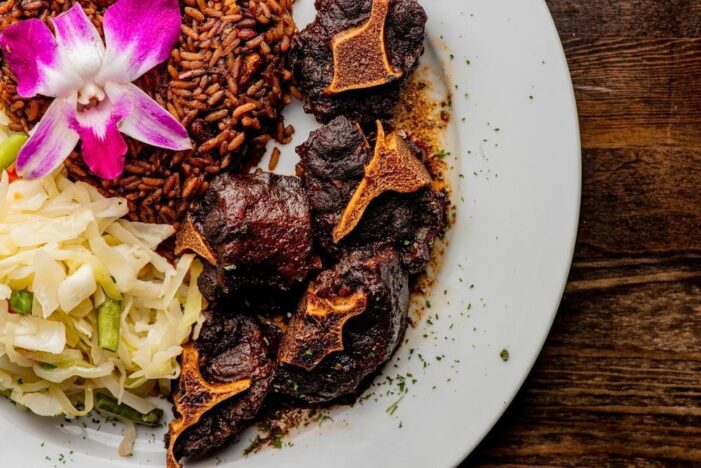By Pearl Phillip
“Grim” is how one restaurant owner describes New York’s restaurant industry today. The Covid-19 pandemic may be officially over. But restaurants continue to feel the impact.
Delicious Caribbean meal of stewed oxtails, rice and peas, steamed cabbage and green peas.
The restaurant industry is integral to New York City’s social and economic DNA. From intimate, family-owned restaurants and food carts to four-star world-famous establishments, New York boosts restaurants that offer cuisines from every part of the world. Restaurants lend vitality to each neighborhood, from Liberty Avenue in Queens to Flatbush and Bed-Stuyvesant in Brooklyn. Restaurants are an essential part of Manhattan’s commercial areas and the city’s vibrant tourism industry, attracting millions of visitors who spend approximately $45 billion annually. In 2019, the restaurant industry contributed about 15 percent of the city’s total taxable sales citywide.
Since the beginning of the Covid-19 pandemic in March 2020, the industry has been heavily impacted. Mandatory closures, stay-at-home and social distancing orders, the start of a severe economic recession, and travel restrictions combined to create an unmatched cataclysm for the industry. Fast forward to 2023, New York City restaurants continue to struggle, some unable to fully recover from Covid restrictions. Those that have not been forced to close face ongoing challenges: back rent to pay, the debate over “Covid cabins,” according to Mayor Eric Adams, inflation, and more. About 65% of restaurants that applied for Federal Restaurant Revitalization Fund grants were shut out as funds in the program were quickly exhausted. Is there a hope for a comeback?
Listen to Business Matters with Andrew Rigie here
An Uphill Battle
Despite the challenges, some restaurants were lucky enough to stay open. But New York’s restaurants face an uphill battle. Paul K, who has some 30 years in the restaurant industry with restaurants throughout New York, Florida, and Georgia, summed up the situation in one word, “grim.”
Inflation and the cost of goods and labor are the most prominent factors impeding the industry’s recovery. Paul shared, “The new labor laws and retirement plans for servers pose a challenge. And there will also be a blowback with the proposed wage increase.”
There are growing fears that many establishments will be forced to close permanently if financial support is not forthcoming. Paul lamented, “During the pandemic, there was financial aid and assistance. We still need this to stay open and survive. As entrepreneurs, we understand there will be ebbs and flows. There are just too many downs now. We need assistance to survive and flourish. I strongly suggest programs to assist the industry.”

Andrew Rigie, Executive Director, NY Hospital Alliance. Photo courtesy: Andrew Rigie
The New York City Hospitality Alliance is a non-profit that advocates for restaurants and nightlife establishments. Andrew Rigie, the Executive Director, explained, “Yeah, it’s been such an extraordinarily difficult few years for the city’s restaurant industry. We are obviously in a better place than we were this time of year over the past three years, but there are still some real challenges, and we see an uneven recovery. Inflation has meant the cost of goods and services has skyrocketed. Labor costs have gone up. And unfortunately, many of these small business owners still have a lot of pandemic-related debt.”
Some great landlords worked with small businesses, including restaurants, to help them stay open or reopen when permitted. But others didn’t want to negotiate with their tenants. At the end of the month, rent needs to be paid.
Rigie noted, “Many restaurants still owe their landlords a lot of money for missed rent. They may have taken out other types of loans that they will be paying off for a long time. We also need to recognize that there’s still a long road to recovery. And just because we may see a busy restaurant doesn’t mean everything is fine and perfect yet.
RELATED
Tipping – The New Dilemma for Patrons
Cost of Doing Business
Since the pandemic began, many restaurants have explored new business models, such as delivery services, to generate revenue. Delivery apps were both a blessing and a burden. Delivery apps act like silent partners, taking from 15% to 40% of each order. The prices on the menus online are sometimes more than on the restaurants’ websites. Some restaurants have decided to deliver their food. So, there’s that and more.
According to Grub Street, “Many restaurants’ menus are getting simpler because of high labor turnover, fewer available cooks, and rising ingredient costs. Chefs are also designing their dishes to be less rigid.” There still are added impediments to staying open and reopening, such as debt and labor shortages.
Rigie shared some insight, “A lot of it is debt and just the cost of doing business. There’s a big challenge. There’s a labor shortage in the industry. While we recently, fortunately, have gained back a lot more jobs, we’re still about 13,000 fewer jobs in the city’s restaurants and bars compared to January or February of 2020, right before the pandemic shut our industry down.”
There’s also the issue of staffing and, because of the high staff turnover, having to train new people. There is a process of getting staff up to a certain standard, and the familiarity and knowledge of experience are missing. According to Rigie, “Many people have left the industry with experience, so they may not be returning. So, it’s getting new people, training people, getting them to understand how to work in a restaurant, and familiarizing themselves. So those are some of the challenges.”
Inflation and the Bureaucracy
The advent of inflation has been like gasoline to the fire. Rigie said, “Inflation has also made it difficult for the everyday consumer because it costs a lot more money to go out and spend on meals or at local bars. So that has been a challenge as well.”
Restauranter Paul K revealed, “People are not coming out to eat as often as they used to. During the second year of the pandemic, delivery services or curbside pickup were utilized more.”
Red tape has always been an enemy of small businesses. It’s a constant battle to cut through rules and regulations, which can be time-consuming, and costly.
Rigie explained, “For example, if someone wants to open a new restaurant, getting a liquor license can take a very long time. And a liquor license is often required. When people want to open up a new restaurant and go out to dine, they want to have a beer, glass of wine, a cocktail, and because it can be very delayed to get one of these licenses, a restaurant could be ready to open up.”
Some restaurants have been waiting to be able to pay back rent for months. And, with inflation hitting simultaneously, the cost of goods has skyrocketed. In May of 2022, the Adams administration took major steps to reduce burdens on the city’s small businesses and cut red tape t by announcing reforms to 118 city regulations. The reforms stem from Executive Order 2 (EO2) “Small Business Forward” — signed in January 2022 — that requires city agencies to review existing business regulations and ensure local businesses face fewer needless fines and penalties without jeopardizing public health or safety. The reforms include the repeal of 30 provisions, the reduction of civil penalties associated with 49 provisions, and amendments to 39 provisions to include a first-time warning or cure period or to extend an existing cure period.
There’s still so much more to be done to help cut the red tape, break through that bureaucracy, and streamline the permanent licensing process so one can open up quickly.
According to Rigie, “Restaurants can’t open until they get the liquor license. So, they could start burning through a lot of their opening capital. And it can be difficult to keep your initial employees if you’re not open. So, there are still some real challenges. It impacts a lot of restaurants in the same way, but then there are specific, unique ways certain businesses are being impacted.”

Remote Work
In January 2023, Mayor Adams stated, “You can’t run New York City from home. That accountant from a bank that sits in an office — it’s not only him. It feeds our financial ecosystem. He goes to the cleaners to get his suits cleaned. He goes to the restaurant. He brings in a business traveler.” A month later, Adams, who seemed to resist working from home, softened his position by agreeing to a hybrid schedule for City employees. This directly impacts restaurants in the city that rely on the daily traffic of employees.
Rigie discussed the impact. “If you’re located in midtown or lower Manhattan, you rely heavily on office workers. However, people are still working remotely, you still don’t have as many customers in the area as you used to, and who knows if they will ever come back to the office five days a week? Probably not. So especially Monday and Fridays tend to be a lot slower for those businesses located in what has been a historical commercial business district of the city.”
Outdoor Dining: Is It Here to Stay?
In his State of the City speech, Mayor Adams surprised people by calling dining sheds “Covid cabins” and saying that they need to be reimagined. Many restaurants would be gone, closed, or kaput without outdoor dining.
Are legislators going to pass laws so that restaurants have the freedom to build outdoor structures? Can the structures stay throughout the year, or must they be removed in the winter? \

Sept 28, 2020 Cafe du Soleil, an Upper West Side French Restaurant installed “space bubbles” for outdoor dining after the lockdown from Covid-19, New York City, USA. Editorial credit: CHOONGKY / Shutterstock.com
Rigie shared how outdoor dining saved thousands of restaurants. “It’s credited with saving about 100,000 jobs, and many restaurants relied on it. But almost every day, I hear from restaurants saying, I want to invest and upgrade and make changes to my outdoor dining because it’s gotten beat up through the summer, the spring, the winter, multiple times over during the pandemic. Still, I don’t want to invest money in it. If next week the City will come and tell me, oh, no, we’re changing all the rules and the game on you again. So, we need clear guidance that’s standardized. So, we don’t have “COVID shacks or sheds.” We have beautiful sidewalk cafes, street trees, outdoor dining, cabanas, and what we need.”
Rigie added, “So, many of the concerns or challenges that have resulted from outdoor dining can be done by creating a more standardized and sustainable system. Remember, this was put up in response to an unprecedented crisis, an emergency. The restaurants had no money. The guidance was constantly changing. Things were open, and then they were shut. You could do this, and you couldn’t do that. People weren’t clear. They didn’t have money to invest. So, we can’t see this model as what the permanent program should look like. But we should use the concept that this program, outdoor dining, has helped thousands of restaurants and hundreds of thousands of jobs.
And people love dining outdoors. And it was equitable and brought outdoor dining to neighborhoods that were never eligible or couldn’t afford it. And as we rebuilt, we heard a lot about this. How do we rebuild a fairer, more equitable city? I think that means having a good program that’s accessible.”
RELATED
Chef Shorne Benjamin Shares Tips for Persons Looking to Get into the Restaurant Industry
Listen to Business Matters with Chef Shorne Benjamin here.
New York, New York, Recovery
Given all the challenges, how can the industry fully recover? Rigie shared his vision.
“Well, at the end of the day, the best thing we could have moving forward is to get to a stable place because there will always be challenges. But people feel good about being in the industry. They feel that the government’s only sometimes out to get them with this fine and that violation or some complex, complicated law will catch them when they are trying to do the best thing. And I hope people can get past the impact of the pandemic by getting rid of that related debt that they have, staffing up to levels like they were before, and creating a more inclusive industry.
He concluded, “We’re so diverse. We have people who work in restaurants and own restaurants from all walks of life, so we want to provide them with the most opportunity to grow and succeed. But the biggest thing we could have right now is to get back to a place where the focus is not on how we will survive due to the pandemic. Let’s deal with new challenges and move on from the pandemic challenges.”
The good news is that we know people want to go out, eat, drink, celebrate, and socialize. Everyone has stories of a special memory with family, friends, and loved ones. The place where they had their first drink, first date, or met the love of their life. For many, it’s more than a meal. It’s a time back to pre-pandemic normalcy.
This story was produced as part of the Small Business Reporting Fellowship, organized by the Center for Community Media and funded by the NYC Mayor’s Office of Media and Entertainment.

